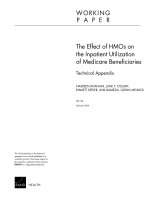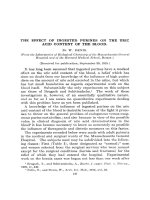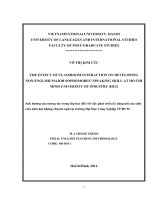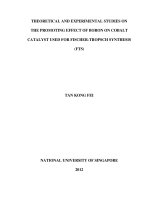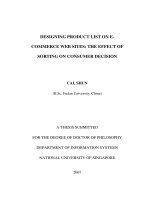Effect of loaded pad thickness on the static behaviors of five-pad hydrodynamic journal bearings
Bạn đang xem bản rút gọn của tài liệu. Xem và tải ngay bản đầy đủ của tài liệu tại đây (481.18 KB, 5 trang )
ISSN 1859-1531 - THE UNIVERSITY OF DANANG - JOURNAL OF SCIENCE AND TECHNOLOGY, VOL. 20, NO. 12.1, 2022
15
EFFECT OF LOADED-PAD THICKNESS ON THE STATIC BEHAVIORS OF
FIVE-PAD HYDRODYNAMIC JOURNAL BEARINGS
Dang Phuoc Vinh*
The University of Danang - University of Science and Technology
*Corresponding author:
(Received: Noverber 02, 2022; Accepted: December 14, 2022)
Abstract - The use of tilting pad journal bearings (TPJBs) has
increased in the recent past due to their stabilizing effects on the
rotor bearing system. Most of the studies about steady state and
dynamic behaviors of TPJBs are usually evaluated by means of
thermohydrodynamic models assuming nominal dimensions for
the bearing. However, machining errors could lead to actual
bearing geometry and dimensions different from the nominal
ones. In particular, for TPJB the asymmetry of the bearing
geometry leads to unexpected behavior of the bearing. In this
paper, effects of non-uniform clearance on TPJBs’ performances
such as clearance profile, shaft locus, power loss, pad tilt angle,
and pressure distribution are evaluated using an analytical model.
The results show that effects of non-uniform clearance on static
characteristics of TPJBs are considerable when evaluating the
efficiency of the bearing in particular and system in general.
Key words - Pad thickness; five-pad; journal bearing; static
behavior
1. Introduction
Since tilting pad journal bearings (TPJBs) are more
stable and efficient than conventional bearings, they have
been frequently applied to many rotor bearing systems. The
essential feature of tilting-pads is that they modify their
configuration to adapt to every operating condition, creating
several convergent-divergent gaps around the circumference
and thus making the system highly stable. A lof of numerical
methods for calculating dynamic coefficients for tilting-pad
journal bearings, extensive theoretical and experimental
studies on dynamic and stability analysis have been
conducted. For the development of journal bearings, many
effective methods have been applied, such as NewtonRaphson method, pad assembly technique, finite elements
method, and genetic algorithm to calculate static as well as
dynamic characteristics of the TPJBs.
The effects of bearing clearance and pad clearance on
the steady-state and dynamic behavior in TPJBs were
theoretically studied in [1]. It can be concluded that the pad
clearance has little effect on the Kyy term at small values of
bearing clearance ratio and the bearing clearance has more
effect than pad clearance. The effects of preload factor,
clearance ratio, load directions, pad thickness, working
temperature on performance of TPJBs were also
investigated by theoretical and/or experimental activities in
some literatures [2] - [9].
A mathematical model was developed to study the
nonlinear dynamics of rotor supported on a TPJB [10]. The
results refer to nonsynchronous and chaotic vibrations
associated with phenomena other than the classical oil
whirl. In particular, it has been shown that two suggested
loading mechanisms successfully lead to the appearance of
rich nonlinear vibrations for the rotor and its supporting
pads. The first one is represented by through-pivot and onthe-pad loading case. The second one is the case of a
concentric rotor with no static biasing load. For the pivot
loaded pads, large static loads lead to large rotor
displacements in the direction orthogonal to the applied
load. It was demonstrated that stabilization against pad
flutter could be improved by geometric preloading.
The dynamic characteristics of TPJBs with asymmetric
pad support using Reynolds equation and an adiabatic
model for the oil film was studied in [11]. It was applied to
a five-pad bearing, and then the pad relative clearance has
influenced the dynamic stiffness and damping coefficients,
while the length-to-diameter ratio has just affected the
direct dynamic stiffness coefficients.
The importance of pad and pivot flexibility in
predicting impedance coefficients for the TPJBs, presented
measured changes in bearing clearance with operating
temperature, and summarize the differences between
measured and predicted frequency dependence of dynamic
impedance coefficients was taken-into-account in [12].
The bearing clearance with pentagonal shape was obtained
as a function of operating temperature. Hot-bearing
clearances and cold-bearing clearances were plotted and
measured hot-clearances are approximately 30% smaller
than measured cold ones and were inversely proportional
to pad surface temperature. The effect of employing a full
bearing model versus a reduced bearing model (where only
journal degrees of freedom are retained) in a stability
calculation for a realistic rotor-bearing system is assessed.
A misaligned journal bearing system using mixed
lubrication model coupling for the asperity contact effect,
elastic deformation, effect of viscosity on oil temperature
and pressure was investigated in [13]. The performance of
model was calculated using finite difference method, and a
test-rig presented in this paper was used to experimental
evaluate the friction and temperature characteristics of the
system. It can be concluded that the pressure distribution,
film thickness, and elastic deformation of the journal bearing
under misalignment conditions should be considered.
The main effects of turbulent flow in TPJBs are
presented in [14]. Turbulence plays an important role in the
design of hydrodynamic bearings in order to increasing
power density in turbomachines and consequently the
operating speeds of the fluid-film bearings.
The static and dynamic characteristics of a large
cylindrical journal bearing operating under severe
conditions namely at very low speed and high specific
16
Dang Phuoc Vinh
pressure were described in [15]. The bearing was assumed
to be uniform geometry with diameter of 160mm and the
length of 145mm.
The pivot flexibility in combination with the fluid film
plays an important role for improving agreement between
theory and experiment on static and dynamic behaviors of
TPJBs. In [16], the model used hinges on a single-pad with
two degree-of-freedom has been developed to investigate
the effect of various geometries and operating conditions
to bearings’ performances. It can be concluded that both
stiffness and damping coefficients depend on the applied
force frequency and the flexibility of the pivot contact
region that provides support for the pad.
In [17] authors presented a method to evaluate the
thermal behavior of a five-pad TPJB using cooling pads.
The influences of oil supply grooves at the trailing edge of
the two loaded pads on the maximum pad temperature of a
large TPJB in non-flooded design were carefully
considered. Experimental and numerical results were
compared on a tested bearing. The experimental results
show a significant decrease of the maximum pad
temperatures. An overall temperature reduction is obtained
for the rear pad in circumferential direction.
However, almost papers studied static characteristics of
TPJB by means of thermohydrodynamic models using
nominal dimensions for the bearing. In practical
applications, the error machining on pads usually occurs
leading to thickness of pads is not identical to each other.
It means that the dimensions of all pads are identical or the
bearing is uniform configuration.
In this paper, effects of loaded-pad thickness, i.e., pad
#1, on the performances of TPJBs such as clearance profile,
shaft locus, power loss, pad tilt angle, and pressure
distribution are evaluated using an analytical model. A
five-pad TPJB with different thickness in one pad is
analytically modelled. Its steady state behaviors are
compared with a symmetric bearing.
pads being able to track the motions of the rotor axis.
Tracking depends on the pad inertia and the stiffness and
damping of the fluid film. During operation, each pad will
assume an inclination such that the resultant of the fluid
film forces passes through the pivot point. Thus the pivot
location influences the pad inclination and the magnitude
of the hydrodynamic pressures that are generated.
In this paper, two bearing models, namely uniform
bearing and non-uniform bearing, are used to evaluate
effects of non-uniform clearance on performances of
TPJBs. For the numerical prediction, a finite-difference
code was developed to solve for the steady-state and
dynamic characteristics of a TPJB using the Reynolds
equation. Pad and rotor position are determined using a
Newton–Raphson algorithm that employs the analytically
perturbed fluid-film stiffness and damping matrices.
The MATLAB code includes a thermal model to
determine bearing fluid temperatures and viscosities. The
temperature of inlet oil used for numerical model is kept at
40 °C and is similar with the practical operating condition
of TPJBs. The structural and operating parameters of two
bearings are given in Table1.
2. Description of the bearing
The TPJBs consists of a set of pads which are
individually pivoted, as shown in Figure 1. The bearing has
five pads, load-on-pad configuration. The pivots are
threaded into an outer retaining ring (or bearing shell) for
positioning and preload adjustment.
3. Results and discussion
In this paper, comparisons between two kinds of
bearing are made in terms of dynamic coefficients,
pressure distributions on each pad, shaft locus, power loss,
and pad tilt angle using the complete dynamic model.
The rotor is run with rotational speeds from 1000 rpm to
3000 rpm and is applied by a static force of 5 kN in vertical
direction. During operating, the temperature of oil is
assumed to keep at 40°C. Moreover, effect of non-uniform
clearance is also considered in terms of load direction.
In this case, the rotational speed of rotor is fixed at 1200
rpm (20 Hz) and direction of static load is changed from 90° to 270°, in steps of 18°.
3.1. Shaft locus
For a bearing used in practice, the static loads (gravity
load, external static load, etc.) are predetermined while the
static equilibrium position is unknown. So, to obtain the
dynamic coefficients, we have to find the static equilibrium
position first. Suppose that the static load applied on rotor
is fixed, the rotational speed of rotor is increased gradually
Figure 1. Geometry of five-pad TPJB
Much of the advantage of the TPJBs depends on the
Table1. Two bearing geometric characteristics and
operating conditions
Item
Bearing diameter (mm)
Machined clearance (mm)
Assembled clearance (mm)
Bearing length (mm)
Angular amplitude of pads (°)
Upper pads
Lower pads
Lubricant
Speed range (rpm)
Thickness – Pad 1 (mm)
Thickness – Pad 2-5 (mm)
Uniform
bearing
100
0.125
0.07
70
60
3,4
1,2,5
ISO VG46
1000 – 3000
16
16
Non-uniform
bearing
100
0.125
0.07
70
60
3,4
1,2,5
ISO VG46
1000 – 3000
15.99
16
ISSN 1859-1531 - THE UNIVERSITY OF DANANG - JOURNAL OF SCIENCE AND TECHNOLOGY, VOL. 20, NO. 12.1, 2022
from 1000 rpm to 3000 rpm. Figure 2 shows the shaft
centers of two bearings at twenty positions corresponding
to twenty rotational speed values of rotor.
17
clearly seen that the displacement of shaft when pad #1 is
loaded in the non-uniform bearing is always greater than
that of the uniform one, especially in the vertical direction
(-90°) with the difference of 10µm.
3.2. Minimum oil-film thickness
Figure 4 shows the effect of non-uniform clearance on
minimum oil-film thickness under varying rotational speed
and static load direction. Oil-film thickness increases with
increasing of speed on both bearings and this thickness of
the non-uniform bearing is always higher than in the
uniform bearing, especially at high speed. It can be
explained that when the rotor speed increases, the center of
shaft tend to climb to the equilibrium position of bearing,
that means the shaft is moved up to the bearing center.
42
40
31
Uniform bearing
Non-uniform bearing
30
38
It is clearly seen that when rotational speed increases,
the center of shaft tend to climb to the equilibrium position
of bearing. It should be noted that the displacements of
shaft in the non-uniform bearing are always larger than
those of in the uniform bearing, nearly about 10 µm at each
position corresponding to the speed of rotor.
It can be explained that because the thickness of pad #1
in the non-uniform bearing is less than 10 µm compared to
pad #1 in the uniform bearing, the center of shaft in the
non-uniform bearing will be lower than 10 µm in the
uniform bearing. At 1000 rpm, the center of shaft in the
uniform bearing is more than 15 µm while this value for
the non-uniform bearing is nearly 23 µm.
40
Uniform bearing
Non-uniform bearing
30
20
Y [ m]
10
0
-10
-20
-30
-40
-40
Load.dir = -90°
-20
0
X [ m]
20
40
Figure 3. Shaft locus of bearing vs. load direction
In terms of load direction, Figure 3 shows the effect of
non-uniform clearance on bearings when varying static
load directions. For the uniform bearing, the shaft locus has
a pentagon shape (look like a circular shape with a radius
approximately 30µm). This is because for a TPJB, the
clearance profile generates a polygon, having number of
sides corresponding to the number of pads in the bearing
[18], [19] and [20]. On contrary, an eclipse shape is
presented for shaft locus of the non-uniform bearing. It is
29
Hmin [m]
Figure 2. Shaft locus of bearing vs. rotational speed
Hmin [m]
36
34
32
30
28
27
28
26
26
24
1000
1500
2000
Speed [rpm]
2500
3000
25
-90°
Uniform bearing
Non-uniform bearing
-18°
54°
126°
198°
270°
Load direction [°]
Figure 4. Minimum oil-film thickness of two bearings
At speed of 3000 rpm, the minimum oil-film thickness
of uniform bearing and non-uniform bearing is nearly 41
µm and 38 µm, respectively.
In terms of load directions, the non-uniform clearance
has a little effect on minimum oil-film thickness of
bearings. It is clearly seen from Figure 4 that the minimum
oil-film thickness in the uniform bearing changes
periodically with load directions, from 26.5 µm to 30.5 µm,
while this periodicity variation cannot be seen in the nonuniform bearing due to asymmetric geometry.
3.3. Pressure distributions
As known that, pressure distribution of oil film is the
most fundamental characteristic of bearing. The pressure
distributions of oil-film on each pad are obtained by
integrating Reynolds equation:
h3 p h3 p h
+
= (U1 + U 2 )
x 12 x z 12 z x 2
h
h
h
+ (W1 + W2 ) − U 2
− W2
+ (V2 − V1 )
z 2
x
z
(1)
where h is the oil-film thickness, p is the pressure in the
fluid-film, µ is the lubricant dynamic viscosity, z is the
axial direction, x is the tangential direction, is the density
of oil. The velocity vector component of the shaft is
described by U1, V1, W1 and that of the pads by U2, V2,
W2. In this paper, the oil-film thickness is evaluated
considering a fixed-pivot point. The oil film thickness is
given by:
h = C p − ( C p − Cb ) cos ( − ) − ( R + t ) sin ( − )
(2)
+ X cos ( ) + Y sin ( ) + r
18
Dang Phuoc Vinh
2500 RPM
2000 RPM
1500 RPM
[°deg]
0.04
0.03
0.02
0.01
0
1000
1200
1400
1600
1800
2000
2200
2400
2600
2800
3000
Speed [rpm]
(a)
0.07
Pad #1
Pad #2
Pad #3
Pad #4
Pad #5
0.06
0.05
0.04
0.03
0.02
0.01
0
1000 RPM
Pad #4 Pad #5 Pad #1 Pad #2 Pad #3
3000 RPM
Pad #1
Pad #2
Pad #3
Pad #4
Pad #5
0.05
[°deg]
This expression is applicable to pads with both the line
type and ball–socket pivots. Radial displacement term r
represents pad displacements due to both inclination and
deflection.
To illustrate the effect of non-uniform clearance on oilfilm pressure distribution, Figure 5 shows the pressure
distributions on each pad of two bearings in load-on-pad
configuration at five different rotational speeds of rotor.
Pressure on each pad increases proportional to
increasing of rotational speed of rotor. It is clearly seen that
the pressure distributions on two bearings are quite similar.
At the pad 1 of the uniform bearing, the maximum pressure
at 3000 rpm is more than 4.0 MPa; this value for the nonuniform bearing is approximately 3.5 MPa.
It can be explained that in the non-uniform bearing,
thickness of pad #1 is smaller than compared to that on the
uniform bearing. It makes the oil-film thickness at pad #1
in the non-uniform bearing larger, so the oil-film pressure
is smaller than that on the uniform one.
0.06
-0.01
1000
4
1200
1400
1600
1800
2000
2200
2400
2600
2800
3000
Speed [rpm]
3.5
(b)
Figure 6. Pad tilt angle of (a) uniform bearing and
(b) non-uniform bearing
3
[MPa]
2.5
2
1.5
1
0.5
0
Length of bearing
(a)
2000 RPM
1500 RPM
1000 RPM
3
2.5
2
1.5
[MPa]
2500 RPM
Pad #4 Pad #5 Pad #1 Pad #2 Pad #3
3000 RPM
1
0.5
3.5. Power loss
The estimated bearing power losses as a function of the
rotational speed is given in Figure 7. The power losses in
both bearings increase linearity with increasing of
rotational speed of rotor. When speed of rotor increases
from 1000 rpm to 3000 rpm, the power loss of two bearings
increases dramatically, from 0.4 kW to 2.3 kW (about 6
times). It can be seen that, power loss in the non-uniform
bearing is always smaller than the uniform one, but the
difference is insignificant. However, this evidence can be
useful for design bearing to reduce the power loss. In
particularly, the power losses of two bearings at low speed
(1000 rpm – 1500 rpm) are quite similar.
2.5
0
Length of bearing
3.4. Pad tilt angle
It can be seen that from Figure 6 the loaded pad, namely
pad #1, in both tested bearings has a very small movement,
nearly 0.03°. Besides, this angle value is quite stable when
rotor speed increases.
On contrary, pad #2 has larger movements but this
displacement decreases with increasing of rotational speed
of shaft. In this kind of bearing, the tilt angle of pad #5 is
the smallest and it increases proportional to rotational
speed. Note that the shaft is assumed to be rotated in
anticlock-wise direction, so the rotor tends to locate on the
left hand side when the shaft is rotated.
In general, the non-uniform clearance has a little impact
on the pad tilt angle of TPJBs. And the tilt pad angle of five
pads on two kinds of bearings will be small at high speed.
2
1.5
[kW]
(b)
Figure 5. Pressure distribution of (a) uniform bearing and
(b) non-uniform bearing
uniform bearing
non-uniform bearing
1
0.5
0
1000
1200
1400
1600
1800
2000
2200
2400
2600
2800
3000
Speed [rpm]
Figure 7. Power loss vs. rotational speed
4. Conclusions
The paper presents effects of non-uniform clearance on
steady-state by comparison two models of five-pad TPJBs.
Because machining errors could lead to actual bearing
geometry and dimensions different from the nominal ones.
In particular, for TPJB the asymmetry of the bearing
geometry leads to unexpected behavior of the bearing. The
analysis model shows that it is necessary to consider effects
ISSN 1859-1531 - THE UNIVERSITY OF DANANG - JOURNAL OF SCIENCE AND TECHNOLOGY, VOL. 20, NO. 12.1, 2022
of the non-uniform clearance on the static characteristics of
TPJBs such as shaft locus, minimum oil-film thickness,
pressure distribution and power loss.
Some conclusions can be drawn from the paper:
1. The pad thickness has the larger effect to the shaft
locus and clearance profile. The clearance profile of the
five-pad TPJB has a pentagon shape.
2. The minimum oi-film thickness increases with
increasing of rotational speed. The bearing with loaded-pad
error has larger film thickness compared to the uniform
bearing.
3. The pad tilt angle of pad#1 of both bearings nearly
stable when working. However, this value has a different
trend for the pad #2 and pad #5.
4. The power loss for the both bearings increases with
rotor speed. But the difference between two bearings is
very small and can be ignored.
[8]
[9]
[10]
[11]
[12]
[13]
REFERENCES
[1] Meherwan P.Boyce, "Bearings and Seals”, Gas Turbine
Engineering Handbook (Fourth Edition), 2012, pp. 557-604.
[2] Dang, P. V., Chatterton, S., Pennacchi, P., Vania, A., Effect of the
load direction on non-nominal five-pad tilting-pad journal bearings.
Tribology International, Volume 98, 2016, Pages 197 – 211.
[3] Chatterton, S., Gheller, E., Vania, A., Pennacchi, P., Dang, P.V,
“Investigation of PEEK Lined Pads for Tilting-Pad Journal
Bearings”. Machines 2022, vol. 10.
[4] Dang, P.V, Chatterton, S., Pennacchi, P, “Static Characteristics of a
Tilting Five-Pad Journal Bearing with an Asymmetric Geometry”.
Actuators 2020, vol. 9, 89. />[5] Dang PV, Chatterton S, Pennacchi P, Vania A, Cangioli F,
“Eccentricity measurements on a five-pad tilting pad journal bearing”.
Proceedings of the 14th IFToMM World Congress, Taipei, Taiwan,
October 25–30; 2015. doi: 10.6567/IFToMM.14TH.WC.OS14.020
[6] Dang PV, Chatterton S, Pennacchi P, Vania A, Cangioli F.
“Behavior of a tilting–pad journal bearing with different load
directions”, International Design Engineering Technical
Conferences and Computers and Information in Engineering
Conference,
Paper
No.
DETC2015-46598;
2015.
8.
doi:10.1115/DETC2015-46598
[7] Chatterton, S.; Pennacchi, P.; Vania, A.; Dang, P.V. “Cooled Pads
for Tilting-Pad Journal Bearings”. Lubricants 2019, 7, 92.
[14]
[15]
[16]
[17]
[18]
[19]
[20]
19
/>Dang PV, Chatterton S, Pennacchi P, et al. “Behavior of tilting-pad
journal bearings with large machining error on pads”. ASME Turbo
Expo, Paper No. GT GT2016-56674, 13–17 June 2016, Seoul,
Korea. DOI: 10.1115/GT2016-56674
Chatterton, S.; Gheller, E.; Vania, A.; Pennacchi, P.; Dang, P.V.
“Investigation of PEEK Lined Pads for Tilting-Pad Journal Bearings”.
Machines 2022, 10, 125. />Abu-Mahfouz, I., and Adams, M. L., 2005, "Numerical Study of
Some Nonlinear Dynamics of a Rotor Supported on a Three-Pad
Tilting Pad Journal Beaing (TPJB)”, ASME Trans., 127, pp. 262272.
S. Strzelecki, "Dynamic characteristics of tilting 5-pads journal
bearing with asymmetric support of pads”, Sixth International
Conference on Rotor Dynamics (IFToMM), University of New South
Wales, Sydney, Australia, 2002, pp. 807–814.
Wilkes, J. C., and Childs, D. W., "Tilting Pad Journal Bearing - A
Discussion on Stability Calculation, Frequency Dependence, and
Pad and Pivot”, ASME J. Eng. Gas Turb. Power., ASME Trans.,
2012, 134.
Guo, H., Bao, J., Zhang, S., Shi, M. “Experimental and Numerical
Study on Mixed Lubrication Performance of Journal Bearing
Considering Misalignment and Thermal Effect”. Lubricants, 10(10),
2022, 262.
Betti, A., Forte, P., Ciulli, E, “Turbulence Effects in Tilting Pad
Journal Bearings: A Review”. Lubricants 2022, vol. 10.
Vinh, D.P., Chatterton, S., Pennacchi, P. “Static and dynamic
behaviors of a cylindrical hydrodynamic journal bearing operating
at very low Sommerfeld numbers”. In: Uhl, T. (eds) Advances in
Mechanism and Machine Science. IFToMM WC 2019. Mechanisms
and
Machine
Science,
vol
73.
Springer,
Cham.
/>Wagner, L.F.; Allaire, P.E, “Tilting-Pad Journal BearingsFrequency-Dependent Dynamic Coefficients and Pivot Flexibility
Effects”, Lubricants, 9(3), 2022, 26.
Buchhorn, N., Stottrop, M.; Bender, B. “Influence of Active Cooling
at the Trailing Edge on the Thermal Behavior of a Tilting-Pad
Journal Bearing”, Lubricants 2021, vol. 9.
Pennacchi P., Vania A., Chatterton S., Pesatori E., "Case History of
Pad Fluttering in a Tilting-Pad Journal Bearing”, Proc. of ASME
Turbo Expo, Glasgow, UK, 2010.
Hargreaves D.J., Fillon M., "Analysis of a tilting pad journal bearing
to avoid pad fluttering”, Tribol. Int., vol. 40, 2007, pp. 607-612.
Chatterton, S., Pennacchi, P., Dang, P. V., Vania, A., "A Test Rig
for Evaluating Tilting–Pad Journal Bearing Characteristics”, Proc.
9th IFToMM International Conference on Rotor Dynamics, Milan,
Italy, vol. 21, 2014.
